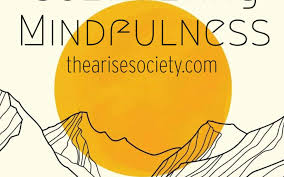In the frenetic pace of modern life, we are constantly bombarded with information, pulled in multiple directions, and encouraged to live in the future – chasing goals, planning strategies, and worrying about outcomes. Our minds become cluttered with anxieties, regrets, and projections, leaving us feeling disconnected from the here and now, the only reality we truly have. This constant mental chatter can lead to stress, anxiety, depression, and a general sense of unease. Enter mindfulness, a practice that offers a powerful antidote to this disengaged existence.
Mindfulness, at its core, is paying attention to the present moment without judgment. It’s about intentionally observing our thoughts, feelings, bodily sensations, and the surrounding environment, acknowledging them without getting carried away by them. It’s about being fully present in our experiences, accepting them as they are, without trying to change, avoid, or control them.
This simple definition belies the profound impact mindfulness can have on our lives. It’s a practice that cultivates self-awareness, reduces stress, improves focus, and enhances overall well-being. It’s not a quick fix or a magic bullet, but a continuous process of training the mind to be present and accepting.
The Roots of Mindfulness:
Mindfulness is not a new concept. It has deep roots in ancient Eastern traditions, particularly Buddhism. The practice of mindfulness, as taught by the Buddha, is an integral part of the path to enlightenment, aimed at cultivating wisdom and compassion. However, mindfulness as it is practiced today in secular settings, while drawing inspiration from these ancient traditions, has been adapted to be accessible and applicable to people of all backgrounds and beliefs.
Jon Kabat-Zinn, a professor emeritus of medicine at the University of Massachusetts Medical School, is widely credited with popularizing mindfulness in the West through his development of Mindfulness-Based Stress Reduction (MBSR) in the late 1970s. MBSR is an evidence-based program that uses mindfulness techniques to help individuals cope with stress, pain, and illness. His work paved the way for the integration of mindfulness into various fields, including healthcare, education, and business.

Key Elements of Mindfulness:
Several key elements underpin the practice of mindfulness, guiding us towards a deeper understanding and implementation of this powerful technique:
- Attention to the Present Moment: This is the cornerstone of mindfulness. It involves consciously directing our attention to what is happening right now, rather than dwelling on the past or worrying about the future. This requires actively shifting our focus from our thoughts and worries to the sensations of our breath, the sounds around us, the feeling of our feet on the ground, or the taste of our food.
- Non-Judgmental Observation: Mindfulness encourages us to observe our thoughts, feelings, and sensations without attaching judgment to them. This means noticing them without labeling them as good or bad, right or wrong. Instead of getting caught up in the content of our thoughts, we simply acknowledge their presence and let them pass. This non-judgmental stance extends to ourselves as well, fostering self-compassion and acceptance.
- Acceptance: Acceptance doesn’t mean resignation or approval. It means acknowledging reality as it is, without resisting or trying to change it. It’s about recognizing that pain, discomfort, and unpleasant emotions are a natural part of life and accepting them without adding further suffering through resistance or judgment. This acceptance allows us to respond more effectively to challenging situations.
- Beginner’s Mind: This refers to approaching each moment with a sense of curiosity and openness, as if we are experiencing it for the first time. It’s about letting go of preconceived notions and expectations, allowing us to see things with fresh eyes. This allows us to be more receptive to new experiences and perspectives.
- Patience: Mindfulness is a practice that requires patience and perseverance. It takes time and effort to train the mind to be present and non-judgmental. It’s important to be gentle with ourselves and to accept that there will be moments when our minds wander. The key is to gently redirect our attention back to the present moment each time we notice our minds drifting.
- Trust: Cultivating trust in ourselves, our intuition, and the process of mindfulness is crucial. Trust that we are capable of handling whatever arises in the present moment. Trust that the practice of mindfulness will guide us towards greater well-being and inner peace.
- Non-Striving: Mindfulness is not about trying to achieve a particular state of mind or reach a certain goal. It’s about simply being present with whatever is happening in the moment, without trying to force or control it. Letting go of the need to achieve a specific outcome allows us to relax into the present moment and experience it fully.
- Letting Go: This involves releasing our attachments to thoughts, feelings, and sensations. It’s about recognizing that everything is impermanent and that clinging to things only leads to suffering. Learning to let go allows us to move through life with greater ease and flexibility.

Practicing Mindfulness:
Mindfulness can be practiced in various ways, both formally and informally.
- Formal Practice: This involves setting aside dedicated time for mindfulness meditation. Common formal practices include:
- Mindful Breathing: Focusing on the sensation of the breath as it enters and leaves the body. This can be done sitting, lying down, or walking.
- Body Scan: Bringing awareness to different parts of the body, noticing any sensations without judgment. This can help to increase body awareness and reduce tension.
- Sitting Meditation: Sitting comfortably and observing thoughts, feelings, and sensations as they arise and pass away.
- Walking Meditation: Paying attention to the sensations of walking, such as the feeling of the feet on the ground and the movement of the body.
- Informal Practice: This involves bringing mindfulness into everyday activities, such as eating, walking, washing dishes, or brushing our teeth. It’s about paying attention to the sensations, thoughts, and feelings that arise during these activities, without getting lost in thought or distraction.
- Mindful Eating: Paying attention to the taste, texture, and smell of food, savoring each bite.
- Mindful Listening: Paying attention to the words and tone of voice of the speaker, without interrupting or judging.
- Mindful Movement: Paying attention to the sensations of movement, such as stretching, yoga, or dancing.

Benefits of Mindfulness:
The benefits of mindfulness are well-documented and supported by scientific research. Some of the key benefits include:
- Stress Reduction: Mindfulness helps to reduce stress by cultivating awareness of our thoughts and feelings, allowing us to respond to stressful situations with greater calm and clarity.
- Anxiety Management: Mindfulness can help to manage anxiety by reducing rumination and worry, and by increasing our ability to tolerate uncomfortable emotions.
- Improved Focus and Attention: Regular mindfulness practice can improve focus and attention by training the mind to be more present and less easily distracted.
- Emotional Regulation: Mindfulness helps to regulate emotions by increasing our awareness of our emotional states and by developing our ability to respond to emotions in a healthy and adaptive way.
- Increased Self-Awareness: Mindfulness cultivates self-awareness by helping us to become more attuned to our thoughts, feelings, and sensations.
- Enhanced Compassion and Empathy: Mindfulness can enhance compassion and empathy by increasing our awareness of the suffering of others and by fostering a sense of connection with all beings.
- Pain Management: Mindfulness can help to manage chronic pain by reducing pain-related distress and by increasing our ability to cope with pain.
- Improved Sleep: Mindfulness can improve sleep by reducing stress and anxiety, and by promoting relaxation.
- Increased Happiness and Well-being: Overall, mindfulness can contribute to increased happiness and well-being by fostering a greater sense of presence, acceptance, and connection.

Challenges and Considerations:
While mindfulness offers numerous benefits, it’s important to acknowledge potential challenges and considerations:
- Initial Discomfort: Some individuals may experience discomfort or restlessness when they first begin practicing mindfulness. This is a normal part of the process, as the mind may resist being still and present.
- Facing Difficult Emotions: Mindfulness can bring up difficult emotions or past traumas. It’s important to approach these experiences with compassion and to seek professional support if needed.
- Time Commitment: Regular mindfulness practice requires a time commitment, which can be challenging for some individuals. However, even short periods of practice can be beneficial.
- Misconceptions: It’s important to dispel misconceptions about mindfulness, such as the idea that it’s about emptying the mind or achieving a state of bliss. Mindfulness is about observing our experiences with awareness and acceptance, without trying to change them.
- Not a Replacement for Therapy: Mindfulness is not a substitute for professional therapy or medical treatment. Individuals with serious mental health conditions should seek appropriate professional help.

Mindfulness in a Broader Context:
Mindfulness is not just a personal practice; it also has implications for society as a whole. By cultivating mindfulness, we can create a more compassionate and sustainable world. Mindfulness can be applied in various contexts, including:
- Education: Mindfulness can help students to improve focus, reduce stress, and enhance emotional regulation.
- Healthcare: Mindfulness can help healthcare professionals to reduce stress, improve patient care, and enhance their own well-being.
- Business: Mindfulness can help employees to improve productivity, reduce stress, and enhance creativity.
- Relationships: Mindfulness can help individuals to improve communication, build empathy, and foster stronger relationships.
Paying Attention & Mindfulness | Sam Chase | TEDxNYU
Conclusion:
Mindfulness is a powerful practice that offers a pathway to greater presence, awareness, and well-being. By intentionally paying attention to the present moment without judgment, we can cultivate self-awareness, reduce stress, improve focus, and enhance our overall quality of life. While it may require patience, persistence, and a willingness to confront discomfort, the rewards of mindfulness are profound and far-reaching. As we navigate the complexities of modern life, mindfulness offers a valuable tool for cultivating inner peace, resilience, and a deeper connection with ourselves and the world around us. Embrace the journey of mindful living, and discover the transformative power of presence.